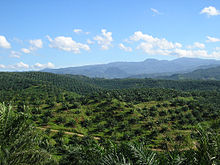
Back Pertanian dan perkebunan di Indonesia ID სოფლის მეურნეობა ინდონეზიაში Georgian Pertanian di Indonesia Malay Сельское хозяйство Индонезии Russian 印度尼西亚农业 Chinese

Agriculture in Indonesia is one of the key sectors within the Indonesian economy. In the last 50 years, the sector's share in national gross domestic product has decreased considerably, due to the rise of industrialisation and service sector. Nevertheless, for the majority of Indonesian households, farming and plantation remains as a vital income generator. In 2013, the agricultural sector contributed 14.43% to national GDP, a slight decline from 2003's contribution which was 15.19%.[1] In 2012, the agricultural sector provides jobs to approximately 49 million Indonesians, representing 41% of the country's total labor force.[2]
Currently, approximately 30% of Indonesia's land area is used for agriculture. Indonesian agriculture sector is supervised and regulated by the Indonesian Ministry of Agriculture.[3]
The agricultural sector of Indonesia consists of:
- Large plantations, either owned by state or private companies;
- Smallholder production modes, mostly family owned and run by traditional agricultural households.
Industrial scale export commodities such as palm oil and rubber, are mainly supplied by large plantations, while the small scale farmers focus on horticultural commodities such as rice, corn, soybeans, Mango, fruits and vegetables in order to meet the food consumption of the local and regional population.[2]
Located in the tropical region, Indonesia enjoys abundant rain and sunshine most of the time, which are important elements for agricultural products to thrive. The country possesses vast and abundant arable fertile soils. As one of the world's major agricultural nations, the country offers wide diversity of tropical products and important agricultural commodities; which include palm oil, natural rubber, cocoa, coffee, tea, cassava, rice and tropical spices.[2]

At present, Indonesia is also the world's largest producer of palm oil,[4] cloves,[5] and cinnamon,[6] the 2nd largest producer of nutmeg[7] natural rubber[8][9] cassava[10] vanilla[11] and coconut oil,[12] the 3rd largest producer of rice[13] and cocoa,[14] the 4th largest producer of coffee.[15] the 5th largest tobacco producer.[16] and the 6th largest producer of tea.[17]
- ^ Estu Suryowati (12 August 2014). "Satu Dekade, Kontribusi Pertanian terhadap PDB Menurun". Kompas (in Indonesian).
- ^ a b c "Pertanian di Indonesia (Agriculture in Indonesia)". Indonesia Investments. Retrieved 5 December 2015.
- ^ "Sejarah Kementerian Pertanian". Kementerian Pertanian RI (Indonesian Ministry of Agriculture) (in Indonesian). Archived from the original on 2015-12-21. Retrieved 2015-12-07.
- ^ "Palm Oil Production by Country in 1000 MT". Index Mundi.
- ^ "Top Production, Cloves, 2012". FAOSTAT. Archived from the original on 2011-07-13.
- ^ "Top Production, Cinnamon (canella), 2012". FAOSTAT. Archived from the original on 2011-07-13.
- ^ "Top Production, Nutmeg, mace and cardamoms, 2012". FAOSTAT. Archived from the original on 2011-07-13.
- ^ "Top Production, Rubber, natural, 2012". FAOSTAT. Archived from the original on 2011-07-13.
- ^ "Chemical Economics Handbook, Natural Rubber". IHS. July 2014.
- ^ "Top Production, Cassava, 2012". FAOSTAT. Archived from the original on 2011-07-13.
- ^ "Top Production, Vanilla, 2012". FAOSTAT. Archived from the original on 2011-07-13.
- ^ "Coconut Oil Production by Country in 1000 MT". Index Mundi.
- ^ "Top Production, Rice Paddy, 2012". FAOSTAT. Archived from the original on 2011-07-13.
- ^ "Top 10 Cocoa Producing Countries". World Atlas.
- ^ "The Top 10 Coffee Producing Countries". World Meters.
- ^ "Leading 10 tobacco producing countries worldwide in 2013 (in 1,000 metric tons)". Statista.
- ^ "The Worlds Top 10 Tea Producing Nations". World Atlas.
© MMXXIII Rich X Search. We shall prevail. All rights reserved. Rich X Search